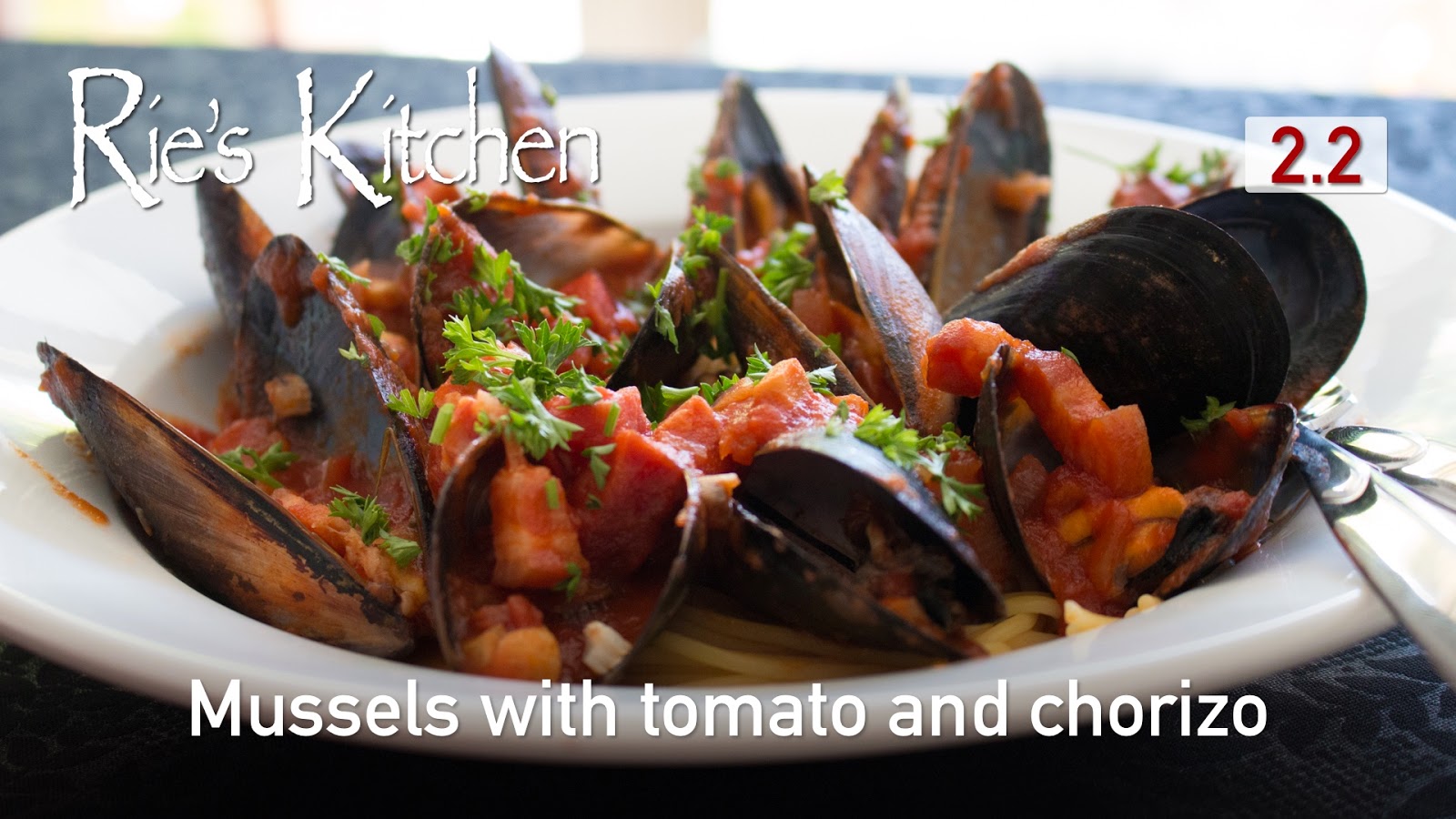Episode 2.2 Mussels with tomato and chirizo
 For those of you who regularly follow my blog, you will be aware that every year in January, I volunteer at the Portarlington Mussel Festival. For the last few years, this has been by doing cooking demonstrations on stage, teaching all the tricks to easily de-beard the mussel, cook them, and importantly tell the mussels that you should not cook. So it seems time, to share some of these tips with you all!
For those of you who regularly follow my blog, you will be aware that every year in January, I volunteer at the Portarlington Mussel Festival. For the last few years, this has been by doing cooking demonstrations on stage, teaching all the tricks to easily de-beard the mussel, cook them, and importantly tell the mussels that you should not cook. So it seems time, to share some of these tips with you all! Firstly, if you can, buy the mussels direct from the farmer! As with all farmers, they are full of helpful tips and recipes. I'm lucky enough to only be 1.5 hours drive from Portarlington, where many of the Victorian mussels are farmed out in the bay. Jennifer from Mr Mussel has taught me many interesting facts about mussels, even how to tell a boy mussel from a girl mussel. - you will have to watch my YouTube video to find out how. :)
Firstly, if you can, buy the mussels direct from the farmer! As with all farmers, they are full of helpful tips and recipes. I'm lucky enough to only be 1.5 hours drive from Portarlington, where many of the Victorian mussels are farmed out in the bay. Jennifer from Mr Mussel has taught me many interesting facts about mussels, even how to tell a boy mussel from a girl mussel. - you will have to watch my YouTube video to find out how. :) Secondly storage - mussels need to be kept refrigerated and damp. The easiest way to do that is in a bowl or foam container in the bottom of the fridge, covered in a damp teatowel. They will stay fresh for 7 days. Alternatively you can cook them, and then freeze them out of the shell, for up to 2 months.
Secondly storage - mussels need to be kept refrigerated and damp. The easiest way to do that is in a bowl or foam container in the bottom of the fridge, covered in a damp teatowel. They will stay fresh for 7 days. Alternatively you can cook them, and then freeze them out of the shell, for up to 2 months.Thirdly - when is a mussel bad and shouldn't be eaten? I hear many of you answering this one by saying "when they don't open when you are cooking them" - WRONG!!
This is a myth and I'll explain why. You should test a mussel for freshness before you cook them, not after ( every mussel in the pot is dead - you just cooked them!). To do this check:
- is the shell broken in any way? - if yes throw this mussel out.
- is the mussel still alive when you take it out of the fridge? A closed shell is an alive mussel - he/she is holding the shell closed. But if the mussel coming out of the fridge is open we need to see if the mussel is still alive. Tap the shell on the benchtop and watch the shell. If the mussel is alive, the shell will slowly close. This one is ready to cook. If no movement in the shell, then throw this mussel out.
The ones that don't open when you are cooking are often the biggest and juiciest mussels. They have started to open during the cooking process, decided that they didn't like it much and closed their shells hard! These are definitely safe to eat, but be careful when opening the shells as they are often filled with very hot water.
For tips on debearding, and to see this recipe in action, visit the link to the Mussels with Tomatoes and Chirizo on YouTube
So now for the recipe.
Mussels with Tomato and Chirizo
Serves 2-3
• 2 doz fresh mussels (approx. 700g)
• 6 button mushrooms sliced
• 1 red onion finely diced
• 150 g speck/pancetta cut into batons
• 1 chorizo finely diced
• 750 ml passata/sugo
• Parsley - chopped as garnish
pasta to serve
Place mussels in a large bowl of tap water and allow to sit for at least 10 minutes. This allows the mussels to open and release some of the salt water and grit inside their shells.
Strain mussels and place in a large pan. Cover with a lid and cook on medium heat. When the pan is foaming, (like a bad Cappuccino) the mussels will have opened. Using tongs, remove opened mussels and place in a bowl. See note below on how to open the closed mussels. When cool enough to handle, de-beard the mussels. Strain the liquid in the pan - this can be used as stock for risottos, soups, or paella.
In a large saucepan, gently fry the speck and chorizo until starting to brown. Add the mushrooms and onion and cook for 3 minutes. Add the passata and stir well.
Meanwhile cook your pasta.
Once pasta is cooked, return mussels to the sauce and stir through to warm them.
Serve on a bed of pasta, garnished with parsley.
Note:
Squeeze the sides of the mussel. The top will open slightly and you will be able to get the point of a knife into the shell. Wiggle the knife down, until you feel the join of the mussel. Push through and the mussel will open. Be CAREFUL, the mussel is likely to be full of hot liquid.
updated February 2023.



Comments